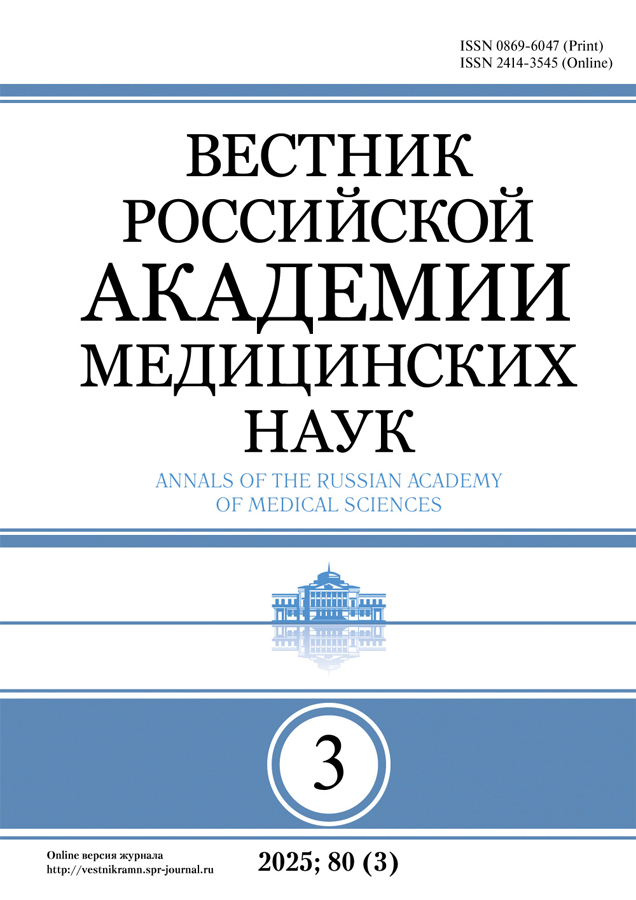ИЗМЕНЕНИЕ ИНО- И ХРОНОТРОПНЫХ РЕЗЕРВОВ СЕРДЦА СТРЕССИРОВАННЫХ ЖИВОТНЫХ В УСЛОВИЯХ БЛОКАДЫ РАЗЛИЧНЫХ NO-СИНТАЗ
- Авторы: Тюренков И.Н.1, Перфилова В.Н.1, Садикова Н.В.1
-
Учреждения:
- Волгоградский государственный медицинский университет, Российская Федерация
- Выпуск: Том 69, № 1-2 (2014)
- Страницы: 46-50
- Раздел: АКТУАЛЬНЫЕ ВОПРОСЫ ФИЗИОЛОГИИ
- Дата публикации: 20.08.2015
- URL: https://vestnikramn.spr-journal.ru/jour/article/view/449
- DOI: https://doi.org/10.15690/vramn.v69.i1-2.941
- ID: 449
Цитировать
Полный текст
Аннотация
Цель исследования: изучить влияние длительного иммобилизационно-болевого стресса на ино- и хронотропные резервы сердца при ингибировании различных NO-синтаз. Материалы и методы: исследование проводилось на 30 белых беспородных крысах-самках. В качестве блока-торов NO-системы использовали аминогуанидин (50 мг/кг); 7-нитроиндазол (50 мг/кг) и N-нитро-L-аргинин-метиловый эфир (L-NAME) (10 мг/кг). Стресс моделировали подвешиванием крыс за дорсальную кожную складку на 24 ч. Изучение функциональных резервов сердца осуществляли с использованием пробы на адренореактивность и пробы изометрической нагрузки. Результаты: установлено, что иммобилизационно-болевой стресс приводит к снижению ино- и хронотропных резервов сердца, что выражается в уменьшении прироста dp/dt+, dp/dt-, левожелудочкового давления и частоты сердечных сокращений по сравнению с контрольной группой интактных животных при проведении нагрузочных проб. Селективная блокада nNOS 7-нитроиндазолом вызывает еще большее снижение ино- и хронотропных резервов сердца у стрессированных животных в условиях нагрузочных проб. Наиболее выраженное угнетение инотропной функции сердца стрессиро-ванных животных наблюдается при неселективном ингибировании NO-синтаз L-NAME. Введение животным аминогуанидина — блокатора индуцибельной NOS до и после стрессирования вызывает увеличение инотропных резервов сердца, что выражается в повышении прироста скоростей сокращения и расслабления миокарда, ЛЖД и ЧСС при проведении нагрузочных проб. Выводы: NO-эргическая система играет существенную роль в ограничении негативного влияния стресса на сократимость.
Об авторах
И. Н. Тюренков
Волгоградский государственный медицинский университет, Российская Федерация
Автор, ответственный за переписку.
Email: fibfuv@mail.ru
доктор медицинских наук, профессор, член-корреспондент РАМК, заведующий кафедрой фармакологии и биофармации ФУВ ГБОУ ВПО «ВолгГМУ» МЗ РФ
Адрес: 400001, Волгоград, ул. Пугачевская, д. 3, тел.: (8442) 97-81-80
В. Н. Перфилова
Волгоградский государственный медицинский университет, Российская Федерация
Email: vnperfilova@mail.ru
доктор биологических наук, старший научный сотрудник лаборатории фармакологии сердечно-сосудистых средств НИИ фармакологии ГБОУ ВПО «ВолгГМУ» МЗ РФ
Адрес: 400001, Волгоград, ул. Пугачевская, д. 3, тел.: (8442) 97-81-80
Н. В. Садикова
Волгоградский государственный медицинский университет, Российская Федерация
Email: arsyonova.n@mail.ru
заочный аспирант кафедры фармакологии и биофармации ФУВ ГБОУ ВПО «ВолгГМУ» МЗ РФ
Адрес: 400001, Волгоград, ул. Пугачевская, д. 3, тел.: (8442) 97-81-80
Список литературы
- Ковалев Г.В., Гурбанов К.Г., Тюренков И.Н., Найденов С.Н. Влияние транквилизаторов на функциональное состояние миокарда при его стрессорном повреждении. Фармакология и токсикология. 1983; 46 (3): 41–44.
- Меерсон Ф.З. Патогенез и предупреждение стрессорных и ишемических повреждений сердца. М. 1984. 269 с.
- Перфилова В. Н. Кардиопротекторные свойства структурных аналогов ГАМК. Автореф. дис. … докт. биол. наук. Волгоград. 2009.
- Тюренков И.Н., Перфилова В.Н., Арсенова Н.В. Влияние иммобилизационно-болевого стресса на ино- и хронотропные функ-ции сердца животных в условиях подавления синтеза оксида азота. Росс. физиол. журн. им. И.М. Сеченова. 2012; 98 (9): 1131–1139.
- Малышев И.Ю., Манухина Е.Б. Стресслимитирующая система оксида азота. Росс. физиол. журн. им. И.М. Сеченова. 2000; 10: 1283–1292.
- Gealekman O., Abassi Z., Rubinstein I., Winaver J., Binah O. Role of myocardial inducible nitric oxide synthase in contractile dysfunction and beta-adrenergic hyporesponsiveness in rats with experimental volume-overload heart failure. Circulation. 2002; 105 (2): 236–243.
- Мацко М.А. Соотношение некоторых медиаторов стрессреализующих и стресслимитирующих систем в остром периоде ишемического инсульта. Патол. физиол. и эксп. тер. 2004; 4: 14–16.
- Herbert J., Goodyer I.M., Grossman A.B., Hastings M.H., de Cloet E.R., Lightman S.L., Lupien S.J., Roozendaal B., Seck J.R. Do corticosteroids damage the brain? J. Neuroendocrinol. 2006; 18: 393–411.
- Малышев И.Ю., Манухина Е.Б. Стресс, адаптация и оксид азота. Биохимия. 1998; 63 (7): 992–1006.
- Balligand J.L., Cannon P.J. Nitric oxide synthases and cardiac muscle. Autocrine and paracrine influences. Arterioscler. Thromb Vasc. Biol. 1997; 17: 1846–1858.
- Buchwalow I.B., Schulze W., Karczewski P., Kostic M.M., Wallukat G., Morwinski R., Krause E.G., Muller J., Paul M., Slezak J., Luft F.C., Haller H. Inducible nitric oxide synthase in the myocard. Mol. Cell. Biochem. 2001; 217 (1–2): 73–82.
- Krenek P., Kmecova J., Kucerova D., Bajuszova Z., Musil P., Gazova A., Ochodnicky P., Klimas J., Kyselovic J. Isoproterenol-induced heart failure in the rat is associated with nitric oxide-dependent functional alterations of cardiac function. Eur. J. Heart. Fail. 2009; 11 (2): 140–146.
- Парахонский А.П. Роль нейрональной NO-синтетазы в патологии сердца. Фундаментальные исследования. 2010; 9: 208–209.
- Парахонский А.П. Кардиопротекторные эффекты индуцируемой NO-синтетазы. Совр. наукоемк. технол. 2010; 9: 207–208.
- Cuevas P., Carceller F., Martinez-Coso V., Cuevas B., Fernandez-Ayerdi A., Reimers D., Asin-Cardiel E., Gimеnez-Gallego G. Cardio-protection from ischemia by fibroblast growth factor: role of inducible nitric oxide synthase. Eur. J. Med Res. 1999; 4 (12): 517–524.
- Bolli R. Cardioprotective function of inducible nitric oxide synthase and role of nitric oxide in myocardial ischemia and preconditioning: an overview of a decade of research. J. Mol. Cell. Cardiol. 2001; 33 (11): 1897–1918.
- Jones S.P., Bolli R. The ubiquitous role of nitric oxide in cardioprotection. J. Mol. Cell Cardiol. 2006; 40 (1): 16–23.
- Muller-Strahl G., Kottenberg K., Zimmer H.G., Noack E., Kojda G. Inhibition of nitric oxide synthase augments the positive inotropic effect of nitric oxide donors in the rat heart. J. Physiol. 2000; 522: 311–320.
- Миронов А.Н., Бунатян Н.Д. Рук-во по проведению доклинических исследований лекарственных средств. М. 2012. 944 с.
- Alvarez S., Boveris A. Mitochondrial nitric oxide metabolism in rat muscle during endotoxemia. Free Radic. Biol. Med. 2004; 37 (9): 1472–1478.
Дополнительные файлы








